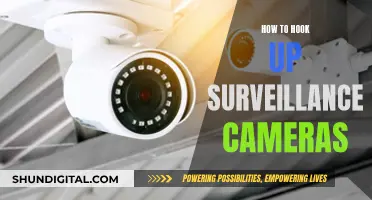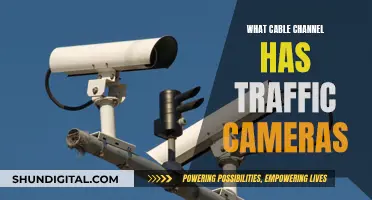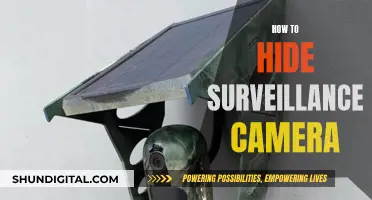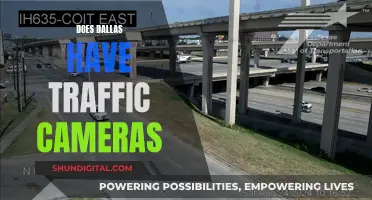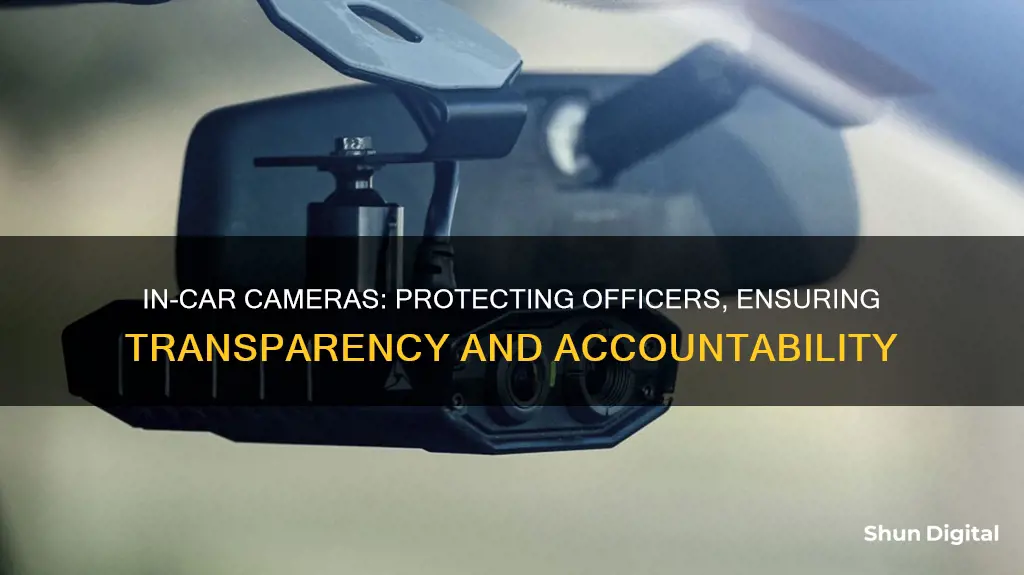
In-car cameras, also known as dash cams, are becoming increasingly common in police vehicles. They serve two main purposes: protecting the public and protecting the police. Dash cams can deter criminal activity, provide a more complete view of incidents, prove innocence or guilt, and help civilians ensure they receive a fair trial. In addition, they can provide an independent, objective record of incidents, which can be used as evidence in court and to increase accountability by monitoring officer activity. Research has shown that the use of body-worn cameras by police officers leads to a decrease in frivolous complaints and a reduction in assaults on officers.
| Characteristics | Values |
|---|---|
| Deterring crime | The presence of in-car cameras can deter criminal activity as individuals are less likely to act out if they know their actions are being recorded. |
| Providing a complete view | In-car cameras can capture images inside the car and in front of it, providing a more complete view of an incident than an officer alone. |
| Proving innocence or guilt | Dash cam evidence can be used to prove or disprove an officer's innocence if they have been accused of a crime. |
| Helping civilians | Dash cams can help ensure civilians receive a fair trial by providing recorded footage of traffic stops and other incidents. |
| Capturing objective records | In-car cameras can provide an objective record of incidents, which can be used as evidence in court and to increase accountability by monitoring officer activity. |
What You'll Learn
- Dash cams can deter criminal activity by making individuals aware their actions are being recorded
- In-car cameras have a more complete view, capturing images inside and outside the car
- Dash cams can prove innocence or guilt, providing evidence in court
- In-car camera systems can help civilians ensure a fair trial when pulled over
- Body-worn cameras reduce the number of frivolous complaints filed against officers

Dash cams can deter criminal activity by making individuals aware their actions are being recorded
Dash cams are becoming increasingly common in police vehicles, and for good reason. One of their most important functions is to deter criminal activity by making individuals aware that their actions are being recorded.
The presence of a dash cam can significantly impact the behaviour of citizens during interactions with law enforcement. People tend to act differently when they know they are on camera, as they are aware that their actions are being recorded and they won't be able to fabricate a story later. This has been confirmed by both officers and citizens in separate surveys, where half of the respondents stated that dash cams helped de-escalate confrontational situations and that their behaviour towards officers would change if they knew a camera was involved.
Additionally, dash cams can provide valuable video evidence that can be used in court. Juries tend to place a high value on visual evidence, and dash cam footage can be crucial in securing convictions. This type of evidence is also useful in reducing fraudulent claims and complaints against officers, as it provides a clear and unbiased account of the incident in question.
Dash cams also improve situational awareness for officers by providing an additional set of eyes. Integrated camera systems can monitor the interior of the police vehicle and capture footage of suspects being transported, even when the officer is driving and unable to directly supervise.
Furthermore, dash cams can assist in investigations by providing a record of the surrounding area during routine patrols. For example, in the case of a reported burglary, dash cam footage from a patrol car that passed by the location can be reviewed to identify any suspicious vehicles or individuals in the area.
While dash cams offer numerous benefits to law enforcement, it is important to consider privacy concerns and adhere to any relevant state and local laws regarding their use.
Charging a Dead DVC Camera Without a Charger
You may want to see also

In-car cameras have a more complete view, capturing images inside and outside the car
In-car cameras are crucial for capturing objective records of incidents. They can capture images inside and outside the car, providing a more complete view of any incident. This can be especially useful when an officer is transporting an arrested person or encounters an inebriated individual, as there is always some degree of risk involved. Eyewitness accounts may be flawed, but if the dashcam can “see” what occurs both in and outside the vehicle, police departments will have a better idea of what actually happened.
For example, the Palo Alto Police Department installed a multiple-camera video system in all of its police cruisers, which provided officers with a broad view of activity surrounding the vehicle. The system included five separate cameras that provided high-definition video and high-fidelity audio. One camera faced out the front windshield like a traditional dashboard camera, while another faced out the back. Two cameras were mounted on the sides of the car and built into the light bar. The final camera kept an eye on the back seat prisoner. Lt. Zach Perron, the police public affairs manager, stated that "the audio and video protect our personnel against frivolous complaints and protect the public against impropriety from an officer."
In-car cameras can also be used to protect civilians when they are pulled over. For example, if a citizen is pulled over for a DUI or traffic infraction, dashcams can help ensure they receive a fair trial by providing a recorded account of the traffic stop. Additionally, civilians can request that all interactions occur in front of the dashcam and have the right to ask for the reasons if the officer directs them away from the camera.
Overall, in-car camera systems with both inward- and outward-facing cameras can provide a more complete view of incidents, capturing images inside and outside the car to protect both officers and civilians.
Surveillance Cameras in Shared Garages: Privacy Invasion?
You may want to see also

Dash cams can prove innocence or guilt, providing evidence in court
Dash cams are small video cameras that can be mounted on a car's dashboard or windshield to record what happens inside and outside the vehicle. They can be a valuable tool for law enforcement officers, providing several benefits that enhance their protection and safety.
One of the most significant advantages of dash cams is their ability to provide video evidence that can prove innocence or guilt in court. This evidence can be crucial in resolving disputes and determining liability in road traffic accidents. For instance, Adam Osmond, a Connecticut resident, used his dash cam footage to dispute a ticket for using his phone while driving. The video evidence was compelling enough that the prosecutor decided to drop the charges without reviewing the footage.
Dash cams can also assist in situations beyond traffic accidents. For example, Osmond was able to help the police investigate a hit-and-run accident by providing video footage of the incident. This type of evidence can be invaluable in identifying suspects and solving crimes.
Additionally, dash cams can provide an impartial record of interactions between officers and civilians during traffic stops or other incidents. This can help protect officers against frivolous complaints and hold them accountable for any improper behaviour. The video evidence ensures a more transparent and objective account of events, benefiting both law enforcement and the public.
It is important to note that dash cam evidence is not always admissible in court and may be subject to locale-specific laws. However, when used appropriately and in accordance with legal guidelines, dash cams can be a powerful tool for proving innocence or guilt, providing valuable visual and audio evidence to support legal proceedings.
Best Cameras Compatible with the AZ16-1 Battery
You may want to see also

In-car camera systems can help civilians ensure a fair trial when pulled over
In-car camera systems are becoming increasingly common among civilians and law enforcement agencies alike. They are an important tool that can help protect both officers and civilians by serving as an impartial witness during police interactions and traffic stops.
In-car camera systems can help civilians ensure a fair trial when they are pulled over by providing an objective record of the incident. This is especially important in cases where there may be conflicting statements from the civilian and the officer. With a camera system in place, civilians can request that all interactions take place in front of the camera, and if an officer directs them away from the camera, they have the right to ask why. This not only protects the civilian but also ensures that the officer's actions are transparent and above board.
Additionally, in-car cameras can capture a more complete view of an incident than an officer alone. They can record images inside the car and in front of it, providing police departments and courts with a clearer picture of what occurred. This can be crucial in situations where an officer is transporting an arrested person or encounters an inebriated individual, as there is always some degree of risk involved in these scenarios.
In-car camera systems also serve as a deterrent to criminal activity. Citizens may be less likely to act out or behave aggressively if they know their actions are being recorded. This can help improve the safety of both officers and civilians during high-pressure interactions.
Furthermore, in-car camera systems can provide evidence in court to prove an officer's innocence or guilt in cases of alleged misconduct. This is essential for ensuring justice is served and maintaining trust in the police and legal system.
Overall, in-car camera systems offer numerous benefits that can help protect civilians' rights and ensure fair trials when they are pulled over by the police. They provide an unbiased account of incidents, deter criminal activity, and improve transparency and accountability in law enforcement.
Fight Camera Speeding Tickets: Spokane Drivers' Guide
You may want to see also

Body-worn cameras reduce the number of frivolous complaints filed against officers
In-car cameras and body-worn cameras can protect officers by reducing the number of frivolous complaints filed against them. A study by Cambridge University found that the introduction of body-worn cameras reduced complaints against officers by 93% over 12 months compared with the previous year. The study monitored almost 2,000 officers across four UK forces and two US police departments.
Dr Barak Ariel, who led the research, said that the results indicated both police and the public were adjusting their behaviour. He suggested that the awareness of being recorded led to behavioural changes that 'cooled down' potentially volatile encounters. The presence of cameras encourages people to modify their behaviour to avoid getting into trouble.
Body-worn cameras also increase transparency and accountability in policing. Footage from these cameras can be reviewed, scrutinised, and submitted as evidence. This can help resolve complaints and lawsuits more quickly and improve interactions between officers and citizens.
In-car camera systems can also provide a panoramic view for police, with multiple cameras offering a broad view of activity surrounding the vehicle. These systems can automatically record video and audio, providing an independent, objective record of what the officer encounters. This can be used as evidence in court and to increase accountability by monitoring officer activity, protecting officers from frivolous complaints.
Simplisafe Camera Costs: When Do You Get Charged?
You may want to see also
Frequently asked questions
In-car cameras protect officers by providing an objective record of incidents, which can be used as evidence in court and to increase accountability by monitoring their activity. This helps to deter criminal activity, prove innocence or guilt, and ensure fair treatment for both officers and civilians during police interactions.
In-car cameras can help to deter criminal activity and reduce assaults on officers by making citizens less likely to act out or behave aggressively when they know their actions are being recorded. Additionally, cameras can provide a more complete view of incidents, capturing images inside and outside the vehicle, which can help protect officers from false accusations or cover-ups.
In-car cameras capture crucial video and audio evidence that can be used to support or refute allegations made against officers. This evidence provides a more detailed and reliable account of incidents than eyewitness accounts, helping to ensure that justice is served and that officers are protected from frivolous complaints.
In-car cameras can help improve police-community relations by increasing transparency and accountability. They provide an impartial record of police interactions, which can be used to address concerns about excessive force, racial profiling, and other issues. This can lead to increased trust and confidence in the police and help to ensure fair treatment for all parties involved.


